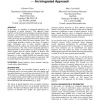Free Online Productivity Tools
i2Speak
i2Symbol
i2OCR
iTex2Img
iWeb2Print
iWeb2Shot
i2Type
iPdf2Split
iPdf2Merge
i2Bopomofo
i2Arabic
i2Style
i2Image
i2PDF
iLatex2Rtf
Sci2ools
98
Voted
HT
1998
ACM
1998
ACM
From Latent Semantics to Spatial Hypertext - An Integrated Approach
In this paper, we introduce an integrated approach to the development of spatial hypertext. This approach brings together several theories and techniques concerning semantic structures, and streamlines the transformation from implicit semantic structures to a semantic space rendered in virtual reality. Browsing and querying become natural, inherent, and compatible activities within the same semantic space. The overall design principle is based on the theory of cognitive maps. Techniques such as latent semantic indexing, Pathfinder network scaling, and virtual reality modelling are used in harmony. The value of this integrated approach is discussed based on initial results of a recent empirical study, which suggests that the spatial metaphor is intuitive and particularly useful when dealing with implicit information structures, or when a highly flexible and extensible virtual environment is required. Search strategies in association with the spatial hypertext and further work are also ...
Related Content
| Added | 05 Aug 2010 |
| Updated | 05 Aug 2010 |
| Type | Conference |
| Year | 1998 |
| Where | HT |
| Authors | Chaomei Chen, Mary Czerwinski |
Comments (0)

